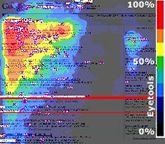Google Search Engine Results Page (SERP) importance
Why is it important for your Irish Recruitment web site to appear high in the search results in Google? Simply because the higher it gets the more likely it is going to be seen. The more the people see your Irish recruitment web site listed in the Google SERP, the more they are going to click on it. The more they click on your job site listed the more relevant Irish job hunters you are going to get!
Eyetools, Enquiro, and Did-it uncover Search's Golden Triangle
New EyeTracking Study verifies the importance of page position and rank in both Organic and PPC search results for visibility and click through.
New EyeTracking Study verifies the importance of page position and rank in both Organic and PPC search results for visibility and click through.
A joint eye tracking study conducted by search marketing firms Enquiro and Did-it and eye tracking firm Eyetools has shown that the vast majority of eye tracking activity during a search happens in a triangle at the top of the search results page indicating that the areas of maximum interest create a "golden triangle."
The first phase of the study was conducted with 50 people in Eyetools' eye tracking lab in San Francisco, California and presented panel participants with 5 distinct scenarios that would require the use of a search engine. Google was used as the search engine in all of the instances.
Key Preliminary Findings of the Study included
Visibility dropped quickly with organic rankings, starting at a high of 100% for the top listing, dropping to 85% at the bottom of the "above the fold" listings, and then dropping dramatically below the fold from 50% at the top to 20% at the bottom.
Organic Ranking Visibility
(shown in a percentage of participants looking at a listing in this location)
Rank 1 – 100%
Rank 2 – 100%
Rank 3 – 100%
Rank 4 – 85%
Rank 5 – 60%
Rank 6 – 50%
Rank 7 – 50%
Rank 8 – 30%
Rank 9 – 30%
Rank 10 – 20%
Eye scan and click through behavior changes dramatically as users moved "below the fold" to the section of results that required scrolling down. At the top of the page, the amount of eye movement declined rapidly through the top 4 or 5 results, and then at the bottom of the screen, tends to become more consistent through to the end of the page.
In searches where top sponsored results are returned in addition to right sponsored ads, the top ads received much higher visibility, being seen by 80 to 100% of participants, as opposed to 10 to 50% of participants who looked at the side sponsored ads.
On side sponsored ads, the top ranked results received much more in the way of both eye activity and click through. About 50% of participants looked at the top ad, compared to only 10% who looked at ads in the 6, 7 or 8th location on the page.
Side sponsored ad visibility
(shown in percentage of participants looking at an ad in this location)
1 – 50%
2 – 40%
3 – 30%
4 – 20%
5 – 10%
6 – 10%
7 – 10%
8 – 10%
There seems to be a "F" shaped scan pattern, where the eye tends to travel vertically along the far left side of the results looking for visual cues (relevant words, brands, etc) and then scanning to the right if something caught the participant's attention.
These results come from an initial analysis of the results and were presented during sessions at the Search Engine Strategies conference in New York. While interesting, the study's main findings are still to come and will required detailed analysis of individual behavior patterns.
Did It's Kevin Lee said, "At this point, we weren't too surprised at what we've seen in the study. We suspected much of this to be true prior to conducting it. However, there is tremendous value in confirming these suspicions, especially in a way that's so visually compelling. It also proves that our methodology will hold up for phase 2 of the research. On the sponsored search side, data indicates that it is the clear branding and visibility advantage offered by gaining top positions, especially Google's top sponsored links. Unfortunately, these aren't always presented with a search. Google is a little fickle in this regard."
Enquiro's Gord Hotchkiss added, "We see a marked difference in how people say they search and what they actually do. Previous research had indicated that people were considered searchers and spent some time before choosing a link. The past few studies we've done, this one included, shows that there's a huge importance placed on where the eyeballs end up on the page. Clicks happen pretty quickly. It just shows that search marketing is a real estate game. It's all about location, location, location."
Eyetools' CTO Greg Edwards also commented, "Eyetracking is the enabling tool that fills in the gaps to understand why people click or don't click — by quantifying what people consider before the decision to click or leave is made, companies can start to better anticipate and design to satisfy people's needs. Applying this in the search results arena enables companies to better plan their marketing communication and increase conversions."
This research is ongoing and the phase 1 results are highly encouraging. After further analysis is done, the results will be made available to the public through white papers. Further findings will be announced as they become available.
For more information about Eye Tracking or the study, see:
No comments:
Post a Comment